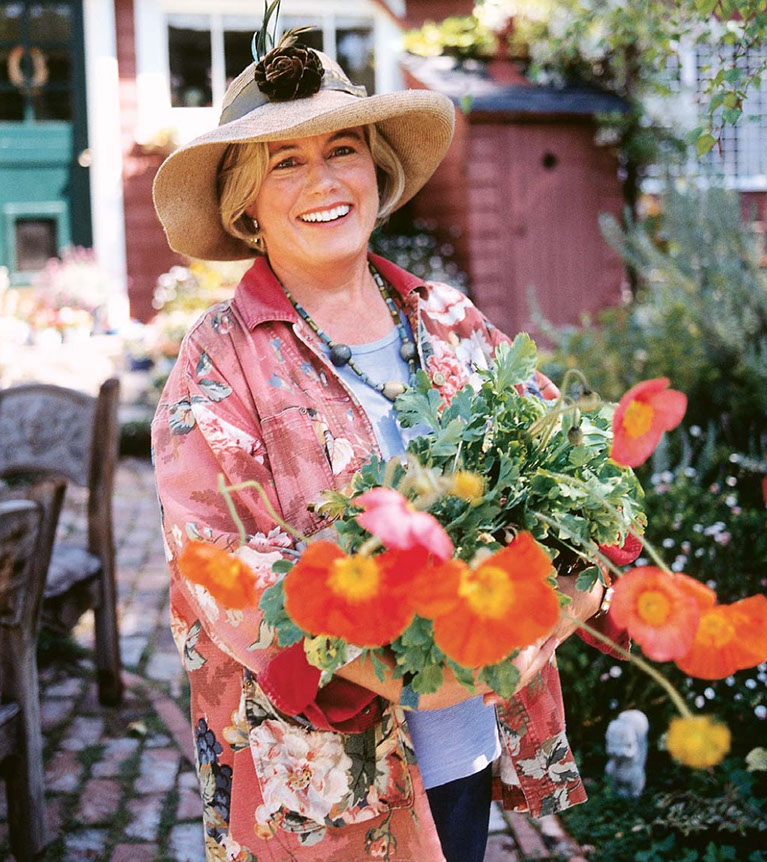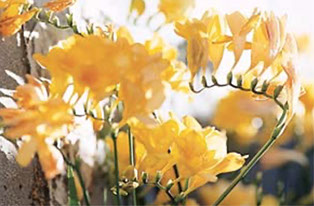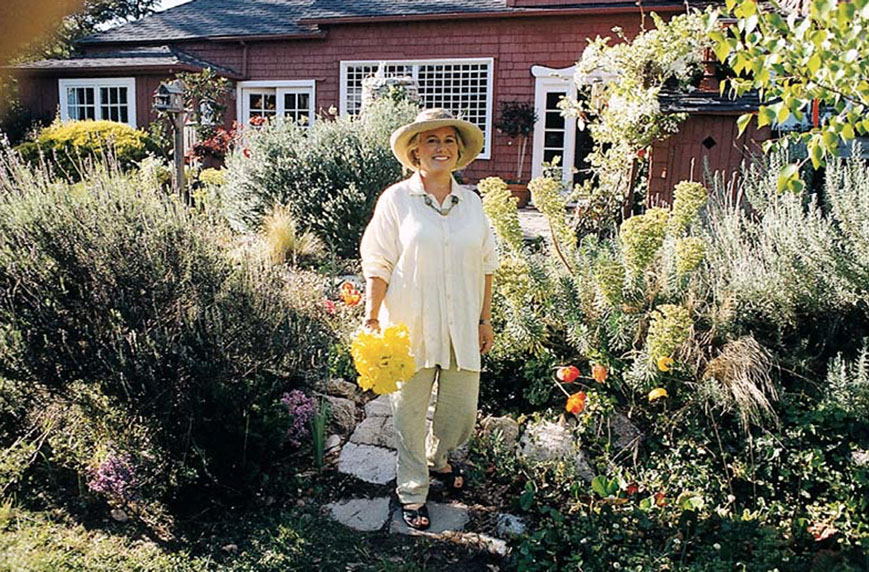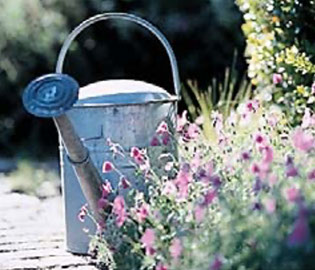
THIS WOMAN WANTS YOU TO STOP AND PLANT—NOT JUST SMELL—THE ROSES AND EXPERIENCE THE CURATIVE POWERS OF MOTHER NATURE

the
garden
healing
By Ellen Michaud
LUGGING half a dozen flats of seedlings down the hilly garden path high above the seals and rocks of the California coast, 49-year-old horticultural therapist and gardener Elizabeth Murray—cheeks pink, blond hair flying, green eyes sparkling—is teaching a dozen of us how to plant a healing garden.
Stripped of our cell phones, PalmPilots, and other techno-gadgets, we’ve dumped our faster-than-the-speed-of-light lives in the dirt and are composting, sowing, hoeing, and reaping to our heart’s content.

THE SEEDLINGS are a humble life form compared with some of the showy plants that Lizzie—the amazing gardener who helped restore artist Claude Monet’s gardens at Giverny—has worked with. Yet studies show that whether you’re planting a show-stopping clump of iris in France or a bucket of wilted impatiens in New York, the experience can lower your blood pressure, reduce pain, reduce stress, lift your mood, and give your immune system a whack upside the head. In fact, just sitting on a rock here in the middle of Lizzie’s garden is enough to do it.
“Plants connect us to ourselves, the earth, each other, even the universe itself,” explains Lizzie. They take our frazzled minds and tattered spirits and ground us in a way that lifts our hearts and renews us: body, mind, and soul. They take us back to the beginning of time when all living things were a part of a single positive energy bent on creation, and human beings were connected by more than just the wireless Internet.
Plants connect us to ourselves, the earth, each other,
and the universe.
In Lizzie’s garden, I feel so deeply calm and untroubled that it’s hard to believe I’m the same terror-stricken woman who yesterday drove a twisting coastal road with hands clamped to the steering wheel, so focused on the road’s hairpin turns, sharp inclines, and drop- away downgrades, that she never got a glimpse of the magical rocks and turbulent ocean hundreds of feet below. But it’s amazing what even a day in the garden will do, and that, of course, is exactly Lizzie’s point.
The Gardener's Gift
Every gardener knows firsthand the incredible sense of quiet joy that working with his hands in warm, rich soil can bring.
The feeling starts in February when tantalizing seed catalogs arrive in the mail, promising us a springtime rampant with daffodils and fragrant hyacinths, and a fall golden with black-eyed Susans, feathery coreopsis, and whole borders of yellow sun- flowers turning toward the sun.
promising us a springtime rampant with daffodils and fragrant hyacinths, and a fall golden with black-eyed Susans, feathery coreopsis, and whole borders of yellow sun- flowers turning toward the sun.
But once the dreaming is over, the plans laid, the seeds bought, and the seedlings grown, to actually step out into the garden and smell the moist earth, feel the warm spring sun on our faces, and see the delicate green life that’s beginning to emerge—it’s a moment that floods us with joy all the way from our wide-brimmed gardening hats to our mud-caked garden clogs. If your family is one of the 85 million households in the U.S. that garden, you know what I mean.
Yet researchers are beginning to suspect that it’s also a moment in which our bodies are flooded with a surge of amazing chemicals that are designed to stimulate our immune systems and promote healing. Triggered by a response to the lush, green plants around us that seems to be hardwired into our neural circuits, these chemicals rush to block the cell-damaging hormones our bodies generate when exposed to illness and the chronic stresses of life in the 21st century. The immediate result is that hormones that promote healing are released, neuropeptides that ease pain spill into the body, we relax, we feel better, and we start to heal.
Hardwired for Green
“The whole idea of green and nature and landscape has been evolutionarily ingrained in us,” explains immunologist Richard Kaufman, MD, assistant professor of medicine at Yale University School of Medicine, an orchid expert, and coauthor of Restorative Gardens: The Healing Landscape (Yale University Press, 1998).
 Show a picture of grassy plains dotted with trees and clumps of vegetation or dense woods nudging a lake to someone in Alaska or Siberia, and even if he’s never seen a green landscape, he’ll prefer it to any other. Why, nobody knows for sure, says Dr. Kaufman. But one thing is clear: Searching out the landscape of a savannah gives the individual a survival advantage—because it’s that type of terrain that invariably leads to food, water, and shelter.
Show a picture of grassy plains dotted with trees and clumps of vegetation or dense woods nudging a lake to someone in Alaska or Siberia, and even if he’s never seen a green landscape, he’ll prefer it to any other. Why, nobody knows for sure, says Dr. Kaufman. But one thing is clear: Searching out the landscape of a savannah gives the individual a survival advantage—because it’s that type of terrain that invariably leads to food, water, and shelter.
The garden’s ability to heal has another way to help us feel better, says Jay Stone Rice, PhD, a California psychotherapist affiliated with the Horticultural Therapy Institute. And that’s its ability to help us understand life and change.
“In depression, for instance, we lose the feeling that we can change,” says Dr. Rice. “We feel stuck. But plants put us in touch with the natural cycles of life and teach us that there’s always a new cycle, a rebirth, a life being renewed.”
Plant Doctors
This knowledge is so therapeutic that there’s even an entire profession—horticultural therapy—that is devoted to the healing power of plants. It recognizes the curative value of gardening and how it soothes the spirit, feeds the imagination, and improves physical and mental well-being. Horticultural therapists work in nursing homes, and with the developmentally disabled, the mentally ill, and prisoners.
Depression makes us feel that nothing can change.
A garden reminds us that everything does.
“Horticultural therapists who work with prisoners realize that to plan, plant, and tend a garden teaches us many things,” says landscape designer Nancy Gerlach-Spriggs, executive codirector of Meristem, a nonprofit organization based in New York that encourages the development of restorative gardens. “It teaches us the fragility of life, that we can’t control everything. It also shows us how important we are in the scheme of things—how insignificant we are in the time and space of the universe, but also how crucial we are to the survival of some of the smallest and most important beings.”

Create Your Own Rx
Sitting in the garden beside an old shingled cottage where she lives in the hills high above Monterey Bay, Lizzie leans back against a 100-year-old chestnut tree and tells me how this place—this garden—kept her among the living after the death of her husband, Gerald.
“I was vulnerable after Gerald died,” remembers Lizzie as her eyes move slowly over the profusion of lavenders, daisies, hydrangeas, bamboo, morning glories, and Monterey pine that surround us. “But the garden grounded and centered me, then helped me move for- ward, just as Monet’s helped him.”
A hundred years before Lizzie worked in his garden and researchers discovered the healing effects of green, growing things, Claude Monet had used his garden to recover from a deep, debilitating depression. When he realized how much his garden had contributed to his own healing, he set out to paint it for the people of France—in the hope that his paintings could heal that war- torn nation as well as it had healed him.
Today, his fabulous gardens and paintings are still healing the world, and wonderful gardeners like Lizzie are showing us how to create our own nurturing spaces. (To lose yourself in one of Monet’s paintings, call the closest art museum to find out if it has any in its permanent collection, or print reproductions in its gift shop. Keep your eye out for any touring exhibitions too).
To gain a garden’s restorative benefits, all you really need is a tiny swatch of green, says Dr. Kaufman. Visit a public garden, place a bonsai by the window, or arrange fresh flowers on a table. It doesn’t take much.
But if you’d like to surround yourself with a healing garden, here are some tips from our experts about how to do it.
Even the smallest garden can be a healing place.
Study the land. What grows where you live? What thrives? What dies? Learn what the land in your area welcomes, and incorporate those plants into your garden, says Dr. Rice.
Think about your passions. “What colors are you drawn to?” he asks. “What kind of textures do you like? What do you like to smell? Your passions are the place to begin,” explains Dr. Rice. They will draw you to the plants you need to heal.
Tune your garden. “Every garden has the potential to be a restorative space—a place where you can leave baggage behind and heal,” says David Kamp, a landscape architect who is designing a living memorial for rescue workers and the victims of the Flight 93 crash near Pittsburgh on 9/11. Kamp feels that sound is an important part of creating a nurturing space.
“Use the wind,” he suggests. “Hang a metal wind chime at the entrance to your garden as a kind of veil you go through when you leave the world behind and enter a healing space. Then hang wooden wind chimes—for deeper, more meditative tones—at several spots in the garden” to encourage contemplation.
Include water. Still water encourages peace and contemplation, says Lizzie. Running water—from a stream or brook or fountain—provides energy. And you can change its sound periodically by moving the rocks around.
Add medicinal plants. “If you’re taking a medicine that’s synthesized from a plant, tuck some of the plant into your garden, and form a relationship with it,” suggests Dr. Rice.
One gardener friend of his who had breast cancer was having difficulty tolerating the drugs used in her chemotherapy. She thought of them as poisons. Every time they were given to her, her body fought them off. Since the woman designed gardens, she decided to put the plants from which her chemotherapy drugs were synthesized into the next garden she designed. She did, and working with the plants—forming a relationship with them, as Dr. Rice says—allowed her to stop fighting the drugs and let them do their work.
Accent with red. A recent study at Kansas State University found that highly stressed women who looked at red geraniums recovered from a new stressor twice as fast as women who simply looked at green foliage. Unfortunately, red didn’t do anything for guys.
Add a bench. Handmade garden furniture has an energy that transforms the garden and enhances your response, says Lizzie. It’s not cheap, but the energy return alone makes it worth the cost.
Use stepping-stones. They’ll force you to slow down, Lizzie says, and consider your own life path.
Create a garden community. Invite people into your healing space, says Lizzie. Unless she’s traveling, for instance, neighborhood children, friends from around the globe, even whole community groups are invited to spend time with her in the garden. “Healing comes into the world with relationships,” says Dr. Rice—a sentiment with which Lizzie agrees.
Return to your roots. Many people grapple with the lost rhythms of their childhood homes, says Dr. Rice. Incorporating some of the plants that touched you as a child will connect you with those rhythms, especially if some of the plants are scented.
“Scent memory is very strong,” he explains. “If you grew up with lilacs, memories of your childhood can be brought back with their smell. If you’re lost, that smell can help you find yourself”—and find your way home.
of your childhood can be brought back with their smell. If you’re lost, that smell can help you find yourself”—and find your way home.
Open your heart. The moment you enter your garden, take a deep breath, slow down, listen to a cricket choir, notice how light goes through leaves, and see how it sparkles on the dew.
“The garden is an opportunity for intimacy with the divine,” Lizzie says. “It’s a portal to God. I believe each plant has a vibration of God within it—not just a reflection, but the actual energy. So when we look at a plant or touch its leaves, it speaks to that of God within us.”
_____________________________________________________________________________________________________________________
Ellen Michaud is an award-winning writer who lives in Northern California. She has written for The New York Times, Washington Post, Better Homes and Gardens, Reader's Digest, Ladies' Home Journal, Prevention magazine and live happy magazine.
Photography by Hilmar.
Prevention magazine

